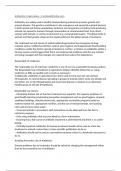Antibiotics in Agriculture – FarmHealthOnline.com
Antibiotics are widely used in healthy food-producing animals to promote growth and
prevent disease. This practice contributes to the emergence and spread of resistant bacteria
in both animal and human populations. Resistant microorganisms carried by food-producing
animals can spread to humans through consumption of contaminated food, from direct
contact with animals, or via the environment (e.g. contaminated water). The global trade in
animals and food greatly enhances the opportunities for the global spread of resistance.
The continued use and misuse of antimicrobial drugs hastens the emergence of drug-
resistant strains. Ineffective infection control, poor hygiene and inappropriate food-handling
conditions enable the further spread of resistance. Further, a reliance on antibiotics within a
farming system would suggest that there are fundamental problems with the way animals
are being managed and that changes are required that reduce the dependency.
Responsible of medicines:
The responsible use of veterinary medicines is one of our key sustainable livestock practices.
The Responsible Use of Medicines in Agriculture Alliance (RUMA) define this as “using
medicines as little as possible and as much as necessary”.
Traditionally, antibiotics in agriculture have been used to treat and cure sick animals
(Therapeutic), to control disease spreading in groups of animals where some are already sick
and others are at risk (Metaphylaxis) and to prevent disease or sickness in an otherwise
healthy group of animals (Prophylaxis).
Responsible use means:
– Minimizing disease risk so that less treatments are required. This requires emphasis on
good health planning emphasizing preventive management such as good hygiene, properly
ventilated buildings, effective biosecurity, appropriate vaccination programs based on
evidence-based risk, appropriate nutrition, and the use of resistant breeds, low stocking
rates and access to clean water.
– Treat sick animals in accordance with instructions on the label and from the farm’s
veterinary surgeon;
– Only using antibiotics that are prescribed by a farm veterinarian;
– Ensuring that a full course of antibiotic treatment is administered and there is no under-
dosing;
– Critically important antibiotics for human treatment should not be used as a first line
treatment in animals, unless there is clear scientific justification to do so.
– Antibiotics should not be used as a preventive measure unless it is absolutely necessary to
do so.
Avoiding Preventive Use of Antibiotics
Disease problems due to husbandry should be solved by changing the management rather
than by the preventive use of antibiotics.
, Preventive treatment with antibiotics in animals should:
– only be applied to animals diagnosed as being at high risk of bacterial disease
– only occur when prescribed by a veterinarian and on the basis of epidemiological and
clinical knowledge
– not be applied routinely
– not be used to compensate for poor hygiene or inadequate husbandry conditions.
Critically important antibiotics for human treatment should not be used preventatively in
animals or as the first line of treatment unless there is clear scientific justification to do so.
Big meat just can’t quit antibiotics (msn)
For decades, evidence had amassed that the widespread use of antibiotics to help chickens,
pigs, and cattle grow faster — and survive the crowded conditions of factory farms — was
causing bacteria to mutate and develop resistance to antibiotics. By 2009, US agriculture
companies were buying up two-thirds of what are termed medically important antibiotics —
those used in human medicine. This in turn has made those precious, lifesaving drugs less
effective for people.
Over time, once easily treatable human infections, like sepsis, urinary tract infections, and
tuberculosis, became harder or sometimes impossible to treat. A foundational component
of modern medicine was starting to crumble. But it wasn’t until the mid-2010s that the FDA
finally took the basic steps of requiring farmers to get veterinary prescriptions for antibiotics
and banning the use of antibiotics to make animals grow faster — steps that some European
regulators had taken a decade or more prior.
Thanks to those two actions alone, sales of medically important antibiotics for livestock
plummeted 42 percent from 2015 to 2017. But according to Matthew Wellington of the
Public Interest Research Group, the FDA’s reforms went after the low-hanging fruit, and
they didn’t go nearly far enough. Now, in a concerning course reversal, antibiotic sales for
use in livestock ticked back up 7 percent from 2017 to 2021, per a new FDA report. The
chicken industry, which had led the pack in reducing antibiotic use on farms, bought 12
percent more antibiotics in 2021 than in 2020.





